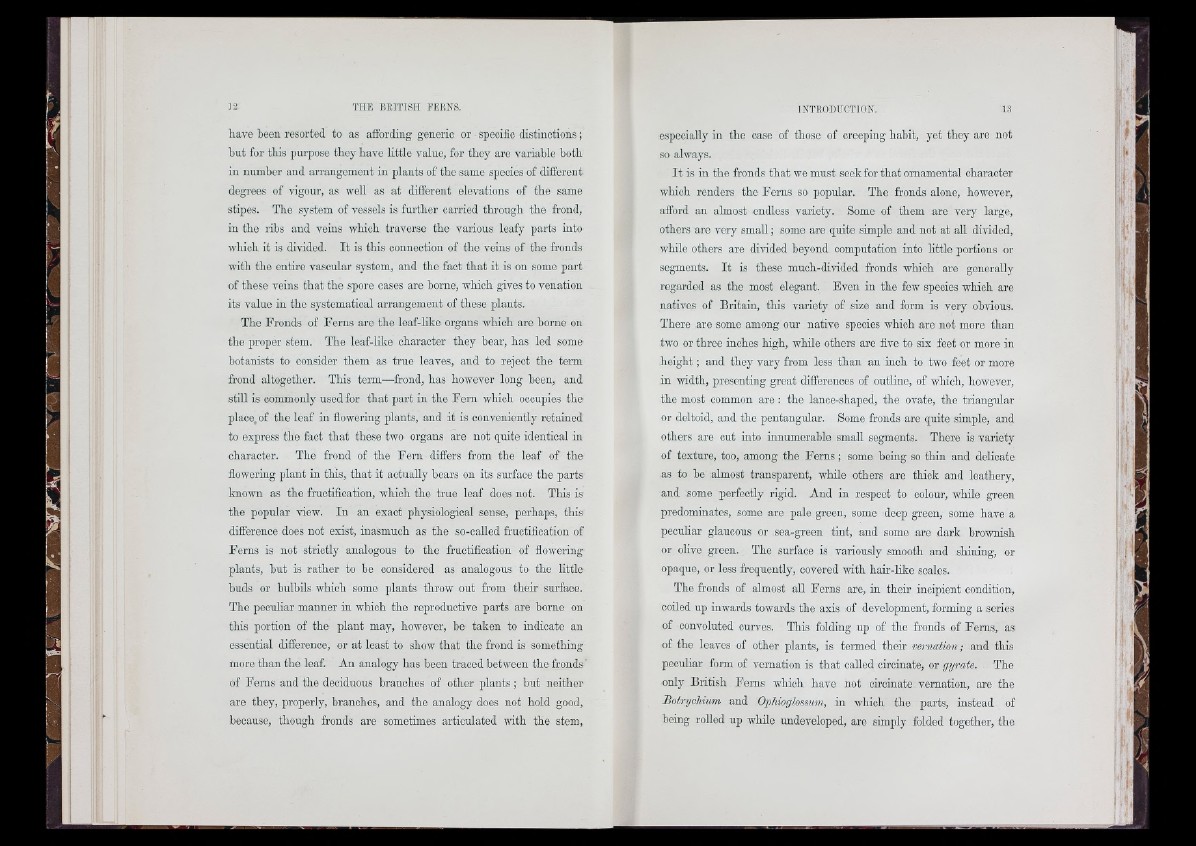
have been resorted to as affording generic or specific distinctions;
but for this purpose they have little value, for they aro variable both
iu number and arrangemont in plants of tho same species of different
degrees of vigour, as well as at different elevations of the same
stipes. Tho system of vessels is further carried through tho frond,
in the ribs and veins which traverse the various leafy parts into
which it is divided. I t is this connection of the veins of the fronds
with the entire vascular system, and the fact th a t it is on some part
of these veins th a t the spore cases aro borne, which gives to venation
its value in the systematical arrangement of these plants.
Tho Fronds of Ferns are the leaf-liko organs which are borne on
the proper stem. The leaf-liko oharaoter they bear, has led some
botanists to consider them as true leaves, and to reject the term
frond altogether. This term—frond, has however long been, and
still is commonly used for th a t part in the Fern which occupies the
place, of tho leaf in flowering plants, and it is conveniently retained
to express the fact that these two organs are not quite identical in
character. The frond of the Fern differs from the leaf of the
flowering plant in this, that it actually bears on its surface the parts
known as the fructification, which the true leaf does not. This is
the popular view. In an exact physiological sense, perhaps, this
difference does not exist, inasmuch as the so-called fruotifioation of
Ferns is not strictly analogous to the fruotifioation of flowering
plants, but is rather to be considered as analogous to the little
buds or bulbils whicb some plants throw out from their surface.
The peculiar manner in which the reproductive parts are borne on
this portion of the plant may, however, he taken to indicate an
essential difference, or at least to show that the frond is something
more than the leaf. An analogy has been traced between tbe fronds'
of Ferns and the deciduous branches of other plants ; but neither
aro they, properly, branches, and the analogy does not hold good,
because, tliough fronds are sometimes articulated with the stem,
especially in the case of those of creeping habit, yet they aro not
so always.
I t is in the fronds that wo must seek for that ornamental oharaoter
which renders tho Ferns so popular. Tho fronds alone, however,
afford an almost ondloss variety. Some of them are very largo,
others aro very small; some are quite simple and not at all divided,
while others are divided beyond computation into little portions or
segments. I t is these much-divided fronds which are generally
regarded as tho most elegant. Even in tho few species which aro
natives of Britain, this variety of size and form is very obvious.
There aro some among our native species which are not more than
two or three inches high, while others are five to six feet or more in
h e ig h t; and they vary from less than an inch to two feet or more
in width, presenting groat differences of outline, of which, however,
the most common aro : tho lance-shaped, the ovato, the triangular
or deltoid, and the pentangular. Some fronds are quite simple, and
others are out into innumerable small segments. There is variety
of texture, too, among the Ferns ; some being so thin and delicate
as to he almost transparent, while others are thick and leathery,
and some perfectly rigid. And in respect to colour, while green
predominates, some are pale green, some deep green, some have a
peculiar glaucous or sea-greon tint, and some are dark brownish
or oKve green. The surface is variously smooth and shining, or
opaque, or less frequently, covered with hair-like scales.
The fronds of almost all Forns are, in their incipient condition,
coiled up inwards torvards the axis of development, forming a series
of convoluted curves. This folding up of the fronds of Ferns, as
of the leaves of other plants, is termed thoir vernation; and this
peculiar form of vernation is that called oiroinate, or gyrate. The
only British Ferns which have not oiroinate vernation, are the
Botrychiiim and Ophioglossum, in which the parts, instead of
being rolled up while undeveloped, aro simply folded together, the